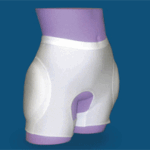 Hip protectors are a promising strategy to reduce the risk for hip fracture from a sideways fall. However, small changes in pad positioning may influence their protective benefit, according to this study by researchers at Simon Fraser University, in Burnaby, British Columbia.
Hip protectors are a promising strategy to reduce the risk for hip fracture from a sideways fall. However, small changes in pad positioning may influence their protective benefit, according to this study by researchers at Simon Fraser University, in Burnaby, British Columbia.
First, the details.
- 3 marketed soft shell hip protectors were tested.
- The researchers recorded changes in the effect of the impact force applied to the hip when the pads were placed in their intended position or offset by 2.5 (1 inch) or 5 cm (2 inches) in various directions.
And, the results.
- For centrally-placed protectors, peak pressure was reduced as follows.
- 93% below the unpadded value by a 16 mm horseshoe-shaped protector
- 93% by a 14 mm horseshoe protector
- 94% by a 16 mm continuous protector
- In unpadded trials, 83% of the total force was applied to the skin overlying the proximal femur (danger zone).
- This was lowered to 19% by the centrally placed 16 mm horseshoe protector
- To 34% by the 14 mm horseshoe
- And to 40% by the 16 mm continuous protector
- Corresponding reductions in peak force delivered to the femoral neck (relative to unpadded) were…
- 45% below the unpadded value by a 16 mm horseshoe-shaped protector
- 38% by a 14 mm horseshoe protector
- 20% by a 16 mm continuous protector
- The protective benefit of all 3 protectors decreased with pad displacement.
- Displacement of protectors by 5 cm too far forward caused peak femoral neck force to increase 60% above centrally-placed values, and approach unpadded values.
The bottom line?
The authors concluded, “These results indicate that soft shell hip protectors provide substantial protective benefits, but decline in performance with small displacements from their intended position.â€
Yes, proper placement makes a difference in the force delivered to the site. But from the patient’s perspective, this study doesn’t address the question of whether this decrease translates into a lower risk of hip fractures.
In response to an earlier study that showed no significant difference in hip fracture risk associated with hip pad placement, Drs. Pekka Kannus and Jari Parkkari of the UKK Institute for Health Promotion Research in Finland commented that positioning of the pad is critical, but studies should evaluate this variable at the time of the fall.
12/21/09 11:56 JR